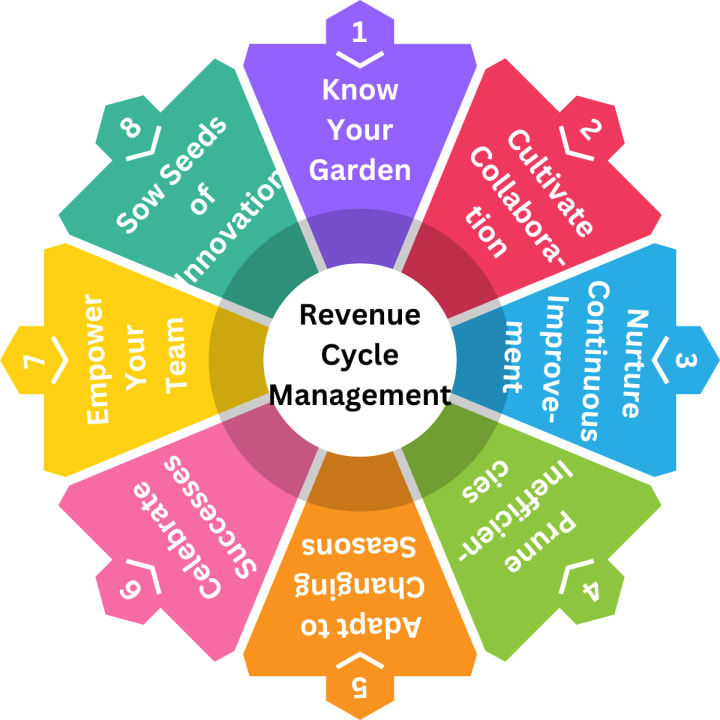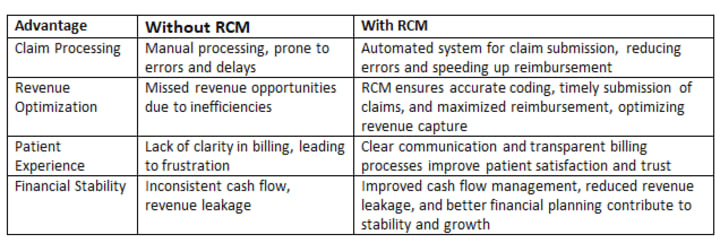
Revenue Cycle Management (RCM) is the integration of patient-centered financial counseling. This involves providing patients with personalized support and guidance regarding their financial responsibilities related to healthcare services. Through proactive financial counseling, healthcare organizations can educate patients about insurance coverage, out-of-pocket expenses, available payment options, and financial assistance programs. By empowering patients with this information upfront, RCM not only ensures transparency and clarity but also fosters a positive patient experience, ultimately leading to improved revenue cycle performance and patient satisfaction.
What is Revenue Cycle Management?
Simply put, revenue cycle management is the process of managing the financial health of a healthcare organization. It encompasses all the administrative and clinical functions that contribute to the capture, management, and collection of patient service revenue. From scheduling appointments to billing and payment, RCM oversees every step involved in generating revenue.
What is healthcare revenue cycle management?
Healthcare Revenue Cycle Management (RCM) is the holistic process that healthcare organizations employ to manage the financial aspects of patient care from beginning to end. It encompasses all administrative and clinical functions that contribute to the capture, management, and collection of patient service revenue. From patient registration and insurance verification to coding and revenue cycle management, billing, claims submission, payment processing, and accounts receivable management, RCM ensures that healthcare providers receive appropriate reimbursement for the services they deliver.
Additionally, RCM involves navigating complex regulatory requirements, payer policies, and industry standards to optimize revenue while maintaining compliance. By effectively managing the revenue cycle, healthcare organizations can enhance financial performance, improve operational efficiency, and ultimately, deliver better patient care.
without RCM what is the need?
Without Revenue Cycle Management (RCM), healthcare organizations may struggle with inefficiencies and inconsistencies in their financial processes, leading to a myriad of challenges. One crucial need that RCM addresses is the optimization of revenue capture and cash flow. In the absence of RCM, healthcare providers may encounter delays in claim submissions, inaccuracies in coding and billing, and challenges in tracking and managing accounts receivable.
These inefficiencies can result in revenue leakage, where organizations fail to capture the full reimbursement they are entitled to for the services provided. Additionally, without RCM's systematic approach to revenue cycle processes, healthcare organizations may face difficulties in identifying and addressing root causes of billing errors, leading to revenue loss and financial instability.
Therefore, the need for RCM is paramount in ensuring the financial health and sustainability of healthcare organizations by maximizing revenue capture and minimizing revenue leakage through efficient and effective management of the revenue cycle.
How To Succeed at Healthcare Revenue Cycle Management

To excel at Healthcare Revenue Cycle Management (RCM), focus on three key pillars: automation, optimization, and collaboration.
Firstly, leverage advanced RCM software to automate repetitive tasks like billing and claims processing, reducing errors and speeding up reimbursement.
Secondly, optimize workflows by identifying inefficiencies and implementing streamlined processes, ensuring smooth cash flow and revenue capture.
Lastly, foster collaboration among revenue cycle teams, clinical staff, and leadership to align goals, address challenges, and drive continuous improvement.
By embracing these principles, healthcare organizations can navigate the complexities of RCM effectively, maximizing revenue while delivering exceptional patient care.
The Advantages For Revenue Cycle Management
Revenue Cycle Management (RCM) lies in its ability to serve as a catalyst for fostering trust and loyalty among patients. Beyond its operational benefits, RCM cultivates a transparent and seamless financial experience, empowering patients with clear communication regarding billing processes and financial responsibilities.
By implementing RCM practices that prioritize patient-centricity, healthcare providers can differentiate themselves in a competitive landscape, building lasting relationships based on transparency, reliability, and empathy. This unique focus on patient trust not only enhances the overall patient experience but also contributes to improved patient satisfaction and loyalty, ultimately driving sustainable growth and success for healthcare organizations.
The Disadvantages For Revenue Cycle Management
Revenue Cycle Management (RCM) lies in the potential for over-reliance on automated processes, which can sometimes diminish the human element in patient interactions. While RCM streamlines billing processes and improves operational efficiency, there's a risk of patients feeling disconnected or marginalized when interactions become overly automated.
Patients may prefer personalized communication and assistance when navigating billing inquiries or understanding financial responsibilities. Over-automation can lead to frustration and dissatisfaction, eroding patient trust and loyalty over time.
Therefore, healthcare organizations must strike a balance between leveraging RCM technologies for efficiency gains while maintaining a human touch in patient interactions to ensure positive experiences and relationships.
Revenue Cycle Management Challenges
In the intricate tapestry of healthcare finance, Revenue Cycle Management (RCM) presents a multifaceted challenge, akin to navigating a maze with shifting walls and hidden passages. Providers must navigate administrative complexities, from deciphering coding languages to addressing denials from insurance payers.
Technological hiccups and communication breakdowns add further layers of complexity, disrupting workflows and hindering efficiency. Regulatory requirements cast a fog of uncertainty, requiring constant vigilance and adaptability to navigate. Amidst these challenges, financial stability hangs in the balance, with revenue leakage and billing inefficiencies threatening the financial health of providers. Yet, within the labyrinth of RCM lies an opportunity for innovation and improvement.
By addressing these challenges with patience, perseverance, and a human touch, healthcare organizations can chart a course to financial success and deliver exceptional care to patients.
The Components of Revenue Cycle Management

Patient Registration: The process begins when a patient schedules an appointment or checks in for a service. During registration, demographic and insurance information is collected, laying the foundation for accurate billing.
Insurance Verification: Verifying insurance coverage is crucial to ensure that services rendered will be reimbursed. RCM involves confirming patient eligibility, coverage details, and obtaining pre-authorizations when necessary.
Coding and Charge Capture: Accurate coding of medical procedures and diagnoses is pivotal for proper billing. This step involves translating the services provided into universally recognized codes, ensuring compliance with insurance requirements and maximizing reimbursement.
Claim Submission: Once services are coded, claims are submitted to payers—whether insurance companies or government programs. Timely submission is vital to expedite payment processing and minimize revenue delays.
Claims Processing and Adjudication: After submission, claims undergo review by payers to determine reimbursement eligibility. This phase involves scrutiny of claims for accuracy, medical necessity, and adherence to contractual agreements.
Payment Posting: Payments received from payers and patients are recorded and reconciled with the billed amounts. Any discrepancies or underpayments are addressed promptly to avoid revenue leakage.
Denial Management and Appeals: Denied claims are a common challenge in revenue cycle management. RCM teams investigate the reasons for denials, rectify errors, and file appeals to maximize revenue recovery.
Patient Billing and Collections: Patient responsibility for deductibles, copayments, and coinsurance must be communicated clearly and collected efficiently. RCM oversees the billing process, generates patient statements, and implements collection strategies when necessary.
The Importance of Revenue Cycle Management
Efficient revenue cycle management is vital for the financial health and sustainability of healthcare organizations. Here's why:
Optimized Cash Flow: Streamlining the revenue cycle accelerates payment collection, improving cash flow and liquidity.
Reduced Financial Risk: By minimizing claim denials and payment delays, RCM mitigates financial risks associated with unpaid accounts and revenue leakage.
Enhanced Patient Experience: Smooth billing processes and clear communication regarding financial responsibilities contribute to a positive patient experience.
Compliance and Revenue Integrity: Adhering to regulatory requirements and payer guidelines ensures compliance and safeguards revenue integrity.
Managing The RCM Process
Embarking on the journey of Reliability-Centered Maintenance (RCM) is akin to nurturing a garden. Just as a gardener meticulously tends to each plant, understanding its unique needs and ensuring its health and growth, managing the RCM process requires a similar level of care and attention.
Imagine yourself as the gardener of your organization's assets, each asset representing a delicate flower in your garden. Your role is to ensure that these flowers bloom vibrantly, contributing to the beauty and productivity of the overall landscape. Here's how you can humanize and effectively manage the RCM process:

1. Know Your Garden: Just as a gardener studies the characteristics of each plant, take the time to understand your organization's assets. What are their critical functions? What are the potential failure modes? By intimately knowing your "garden," you can tailor your maintenance strategies effectively.
2. Cultivate Collaboration: Gardens flourish when there's teamwork involved. Similarly, managing the RCM process requires collaboration across various departments – from maintenance and operations to engineering and management. Encourage open communication and shared insights to cultivate a culture of reliability.
3. Nurture Continuous Improvement: A garden is never static; it evolves with time and care. Similarly, RCM is an ongoing process that requires continuous improvement. Regularly review and refine your maintenance strategies based on new data, technological advancements, and lessons learned from past experiences.
4. Prune Inefficiencies: Just as pruning removes dead or overgrown branches to promote healthy growth, identify and eliminate inefficiencies in your maintenance processes. Streamline workflows, optimize resource allocation, and prioritize tasks based on risk and criticality.
5. Adapt to Changing Seasons: Seasons change, and so do operational conditions. Stay adaptable and resilient in the face of uncertainties. Embrace change and be proactive in adjusting your maintenance strategies to align with evolving business goals and external factors.
6. Celebrate Successes: Every blooming flower in your garden is a cause for celebration. Similarly, acknowledge and celebrate successes in your RCM journey. Whether it's a significant reduction in downtime, cost savings, or improved asset reliability, recognize the efforts of your team and the positive impact of effective maintenance practices.
7. Empower Your Team: Just as a gardener empowers their assistants with knowledge and tools, empower your team with the necessary training and resources to execute RCM effectively. Invest in education, provide access to cutting-edge technologies, and foster a sense of ownership and accountability.
8. Sow Seeds of Innovation: Innovation is the seed that propels growth. Encourage creativity and innovation within your maintenance team. Explore new technologies, methodologies, and Best RCM Companies to enhance the effectiveness and efficiency of your RCM process.
In essence, managing the RCM process is not just about optimizing asset reliability; it's about nurturing a culture of care, collaboration, and continuous improvement. By humanizing the process and embracing its complexities with empathy and diligence, you can cultivate a thriving landscape of reliability and resilience within your organization.
Advantages of Revenue Cycle Management (RCM) for ABC Medical Center
let's consider a hypothetical healthcare organization, ABC Medical Center, and illustrate the advantages of implementing Revenue Cycle Management (RCM) compared to operating without RCM:

This table highlights how implementing RCM can positively impact various aspects of ABC Medical Center's operations compared to operating without RCM.
Steps for an Effective Revenue Cycle Include
Optimized Patient Engagement: Proactively engage patients, providing clear financial information and support.
Efficient Registration Process: Streamline registration to capture accurate patient and insurance details promptly.
Thorough Insurance Verification: Verify insurance coverage to ensure accurate billing and minimize claim denials.
Accurate Coding and Documentation: Implement robust training and tools for precise coding and documentation.
Timely Claims Submission: Submit claims promptly, leveraging technology for efficient processing and reimbursement.
By following these steps, healthcare organizations can establish an effective revenue cycle process that optimizes reimbursement, reduces administrative burdens, and improves overall financial performance.

Implementing Effective Revenue Cycle Management
Implementing an effective RCM strategy requires collaboration across departments, utilization of technology, and continuous process improvement. Regular performance monitoring, staff training, and leveraging data analytics are key to identifying bottlenecks and optimizing revenue cycle efficiency.
What Is the Overall Goal of RCM?
At its heart, the goal of RCM is to ensure that healthcare providers can focus on what truly matters: providing exceptional care to patients. Think of RCM as the guardian angel of the healthcare system, tirelessly working behind the scenes to ensure that financial operations run smoothly, so healthcare professionals can devote their time and energy to healing and helping patients. By optimizing revenue processes, minimizing errors, and maximizing reimbursements, RCM empowers healthcare organizations to fulfill their mission of delivering high-quality care while also maintaining financial health. It's like having a trusted ally in the journey towards better patient outcomes and a stronger, more sustainable healthcare system.
The RCM Choreography:
At the heart of RCM lies a series of intricate steps:
Patient Pre-Registration: It starts with gathering patient information, insurance details, and verifying coverage. Accuracy here ensures a smoother journey ahead.
Appointment Scheduling: Efficient scheduling minimizes no-shows and optimizes resource utilization.
Insurance Verification: Thorough verification ensures accurate billing and prevents claim denials.
Charge Capture: Every service provided must be accurately recorded to avoid revenue leakage.
Claims Submission: Timely submission of claims maximizes reimbursement and reduces cash flow bottlenecks.
Payment Posting: Payments need to be accurately posted against services rendered, ensuring transparency and accountability.
Denial Management: Denied claims are like hurdles in the RCM marathon. Effective management is key to optimizing revenue.
Patient Statements and Follow-Up: Transparent communication with patients regarding their financial responsibility fosters trust and improves collections.
The Role of Technology:
In this digital age, technology serves as the enabler of efficient RCM. From sophisticated billing software to predictive analytics, technological advancements streamline processes, minimize errors, and enhance financial performance.
Challenges and Opportunities:
While RCM is vital, it's not without its challenges. Complex regulatory requirements, evolving payer landscapes, and billing complexities often pose obstacles. However, each challenge presents an opportunity for innovation and improvement.
The Human Touch:
Behind every successful RCM strategy lies a team of dedicated professionals. Their expertise, empathy, and attention to detail ensure the smooth flow of revenue within the cycle.
Factors That Can Affect RCM
Cultural and societal norms play a unique role in influencing patient behavior and healthcare utilization patterns, impacting Revenue Cycle Management trends. Beliefs, attitudes, and socioeconomic factors can vary widely among different demographic groups, affecting decisions regarding medical care and billing processes. Healthcare organizations must consider these cultural nuances when designing RCM strategies, tailoring communication and support services to meet the diverse needs of patient populations. By fostering cultural competence within RCM, organizations can enhance patient trust and satisfaction while optimizing financial performance.
Conclusion
In conclusion, Revenue Cycle Management (RCM) stands as the cornerstone of financial health and operational efficiency within healthcare organizations. It embodies a comprehensive approach to navigating the intricate pathways of patient care, from initial engagement to reimbursement realization. By seamlessly integrating technology, processes, and human expertise, RCM empowers healthcare providers to navigate the complexities of billing, coding, and reimbursement with precision and agility. Ultimately, RCM serves as the compass guiding healthcare organizations towards sustainable financial success while upholding their commitment to delivering exceptional care to patients.
About the Creator
Aftermedi
Leading supplier of all-inclusive RCM services, Aftermedi caters solely to the needs of healthcare organizations.






Comments
Aftermedi is not accepting comments at the moment
Want to show your support? Send them a one-off tip.